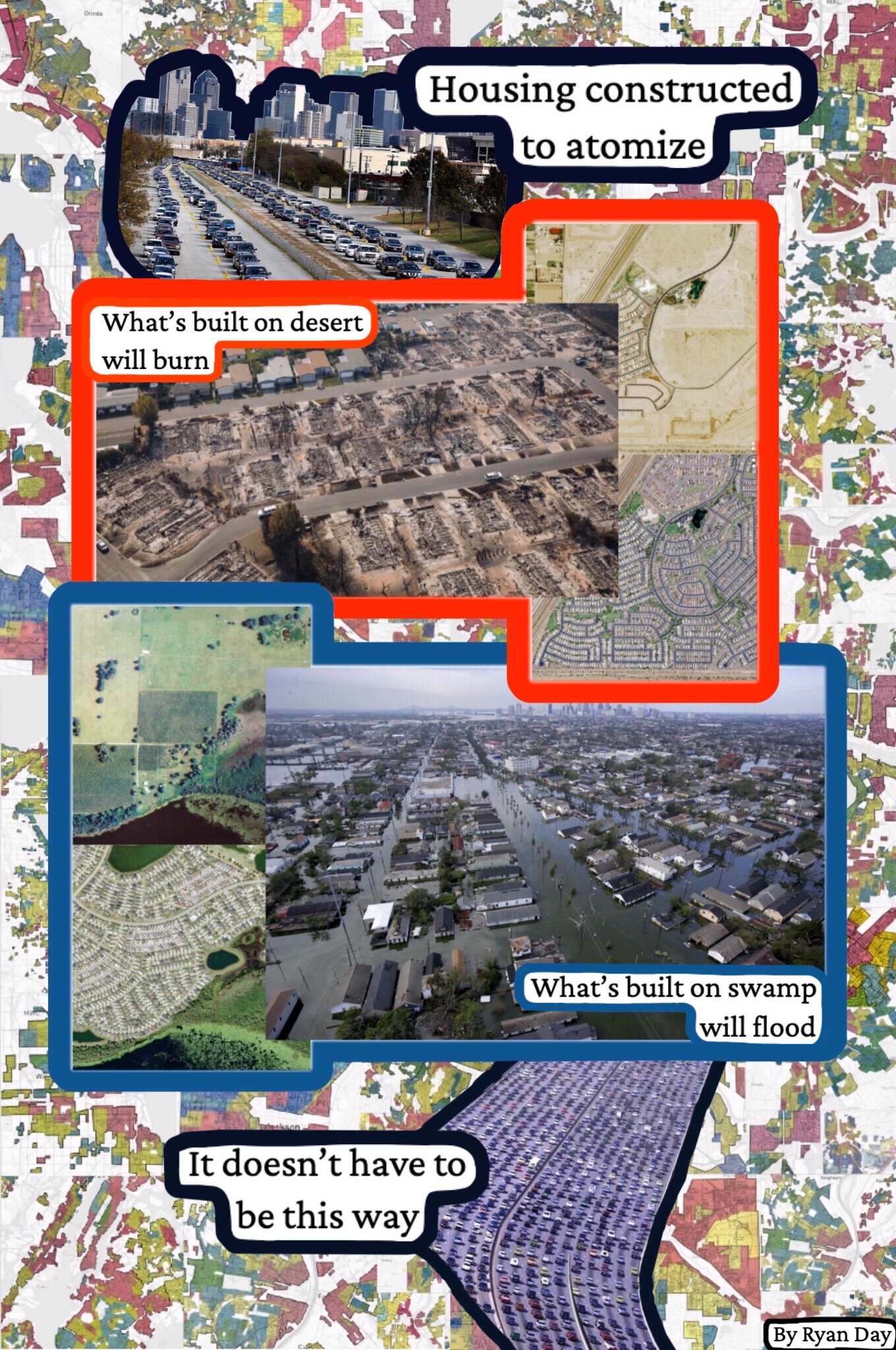
My visual essay intends to demonstrate, using a myriad of different images, the negative effects of our alienating housing in this country, as well as all of the consequences of this sort of suburban sprawl. The images used each demonstrate a subtly different issue that stems from the mass construction of these sorts of homes. Each one can actually, upon closer look, explain one single facet of our housing system and its flaws.
For starters, I take such an interest in this specific topic not just because I grew up in one of these buildings I now detest, but because I can see all around me the effects, and can therefore pretty accurately, in my opinion, pinpoint certain absurdities of the current arrangement. For instance, the bottom image, one of a huge swath of highway entirely covered in bumper to bumper traffic, is all too familiar to some of the roads and highways on Staten Island. I know first hand the hassle involved in these long lines and their waste of time, energy and materials. However, growing up on Staten Island I also know we live not five miles away from the major arteries of the MTA, one of the most comprehensive and effective public transit systems in the country. Yet, due to the rampant construction of single family homes and the single person vehicles that go with it, we do not currently have such easy access to rapid transit, either around the island or into other boroughs the city of Staten Island is supposed to be part of. My overall vision of this project is that by confronting people with the ridiculousness of these dwellings, from an overhead and physical view, they will move at least slightly closer to a different and better set up for living in this country. It should be made clear, though, that my visual essay was made for the left wing online publication Jacobin, and as such the readers should at least be vaguely aware of the problems at hand. This is best presented in the background of the essay, which is a collage of major American cities, overlaid with their respective redlined housing maps. To many viewers, they would not be able to identify these 20th century maps, but for that audience it is clear I am referencing them as being deeply connected to the continuing racial segregation that results from the mass construction of rings of suburbs that leave the inner cities to rot, all while using racism as a helpful pretext for doing so. Furthermore, the work tries to use with images what my opinion editorial does with words. In fact, the centerpieces of the image, pictures of New Orleans, the L.A. metro area, Phoenix and Florida suburbs mirrors the editorial, in which most of the same geographic areas and their problems(burning, flooding) are discussed. On the other hand, some of the images used are not mirrored in the article, and I would like to discuss them here to offer context into what is a darkly ironic situation. On the top half of the image, there is another cavalcade of cars, with the Dallas city skyline behind them. That is no ordinary traffic jam, but a pre-Thanksgiving line to a local food bank, the drivers waiting to get turkeys during the 2020 COVID recession(or depression). A city like Dallas is a quintessential American suburb city, with low density housing extending for miles around the core and thus necessitating the need for all those individual cars to travel. Here I found a real contradiction, where our society forces people to own these massive and wasteful vehicles and homes, so much so that even if you can’t afford basic food during a downturn, you still must have them in order to survive, probably accruing serious mortgage or car loan debt along the way. This sort of prioritizing, done not really by individuals but by the state and capital, of big consumer products over actual human needs, is why I find suburbs in America such a clear and understandable point of contradiction between what we have and what we need.
Overall, the need to expose these under-reported problems in this country are why I had both Op-Ed and Visual Essay devoted to them. American suburbs, and all of the baggage that comes with them, are extremely detrimental to every aspect of what makes us a functioning collective, not just individual people. Completely detached by these blocks, and surrounded by the environmental degradation, racial animosity and stressful situations of the modern world, they allow for us to fester in our singular anger instead of gathering and instituting the change needed to put an end to all of these issues. Citations
Leo, Samuel. “Traffic.” Flickr, 20 May 2009, www.flickr.com/photos/samuel-leo/3550983108/in/photolist-6pMHyG-2hnegbL-2emQ6Rv-4bz9v3-22tzZZG-RXuu7K-2jGwXwq-B2YApx-2i6dyuo-9c2daj-B4LukT-6uvNfw-993dJg-aCpqY-v544L7-ALzhG9-2HfNj-o5sj5j-4EmyCq-NwxCYr-7KnmfZ-dDQYi-drBXMN-aDkADr-87SwfE-2ks2k4f-2earsoV-atx9CN-rcqfGZ-23RsER4-93JL8Q-27qvCQG-3yFkGF-RRTDu9-GvVU5-pJh8U6-RAKjoy-oX7yRR-2ixRdgB-ZDNgjm-2juVQ6Q-GLE2bo-avdEo1-URCb5Q-QRiVRX-2gjDivZ-7CX19-2eG4zAW-eX7Eva-2N6yg.
Nelson, Robert K. “Mapping Inequality.” Digital Scholarship Lab, dsl.richmond.edu/panorama/redlining/#loc=5/39.1/-94.58.
Badger, Emily, and Quoctrung Bui. “A Decade of Urban Transformation, Seen From Above.” The New York Times, The New York Times, 27 Dec. 2019, www.nytimes.com/interactive/2019/12/27/upshot/america-from-above.html.
Fox, Tom. Dallas News, Grant S. Moise, Dallas, Texas, 14 Nov. 2020, www.dallasnews.com/news/public-health/2020/11/14/thousands-pour-into-fair-park-for-north-texas-food-banks-largest-distribution-yet-during-pandemic/.
Laforet, Vincent. NPR, 30 Aug. 2016, www.npr.org/2016/09/30/495794999/new-maps-label-much-of-new-orleans-out-of-flood-hazard-area.
Yam, Marcus. Los Angeles Times, 25 Oct. 2017, www.latimes.com/local/lanow/la-me-ln-coffey-park-explainer-20171011-story.html.

